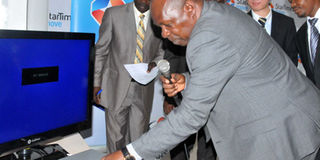Digital migration awareness lacking

Mr Charles Bakabulindi (L), the State Minister for Sports switches on a decoder during the launch of a local sports content programme in Kampala recently. File Photo.
What you need to know:
There has been less awareness conducted especially on matters related to the digital switch.
Beginning next month, it is expected that a cross-section of analogue TV set owners will be able to view digital images if they acquire prescribed Set Top Boxes (decoders)) compatible with digital technology.
The Uganda Communications Commission (UCC), the regulator of broadcasting services, recently announced that it had finalised plans to switch Kampala and the surrounding districts from analogue to digital broadcasting.
The switch is a global requirement that necessitates all countries to have migrated from analogue to digital broadcasting by 2015.
In this regard, UCC competitively selected the United States’ Haris International to supply and install modern broadcasting equipment for the Greater Kampala project completion expected at the end of this month.
The first phase digital switch project, will as well cover the districts of Wakiso, Buikwe, Nakasongola and Mityana.
UBC Television still remains the sole signal distributor despite protests from private broadcasters saying the television station should not be given monopoly since it’s also a competitor in the market.
However, the switch according to critics, lacks the consumer awareness spectrum, a key factor for its successful implementation.
Whereas UCC has started on the phased switch process, which will temporarily enable analogue transmission work together with digital, however, the same will not be possible after the migration deadline.
This means that analogue TV set owners will not be able to access digital images yet less information has been availed to them.
UCC’s public awareness has not stretched beyond a few media adverts and billboards scattered across the country, moreover in one language, yet not comprehensively explanatory of what the technology is all about.
Whereas, Mr Fred Otunnu, the director communications and consumer affairs at UCC accepts there has been less public awareness, there are plans to close the vacuum in the yet to be rolled out sensitisation drive.
Consumers who would by the time have not acquired Set Top Boxes will not be able to view digital images even for local channels, including Bukedde, WBS, NTV, UBC, NBS and Record, among others.
In an interview with Prosper recently, Mr Kevin Chen, the StarTimes Uganda chief executive officer, said there are fears that pay Tv service providers could be overwhelmed with demand for decoders when UCC finally switches to digital broadcasting.
“For instance, he said, ‘our subscription base in Tanzania doubled recently when the government switched to digital broadcasting in some parts of the country.”
Recently, the ICT state minister, Nyombi Thembo said private industry players must become key partners in assisting the government penetrate hard-to-reach [rural] areas as well as enhancing the use of digital migration.
Thus in doing so, StarTimes, including other pay Tv service providers, have been involved I a number of activities as they seek to enhance the implementation of the digital switch.
Recently the Minister of Works and Transport, Mr Abraham Byandala, launched the solar digital television system that would enhance penetration in rural areas.
Uganda has about five million Tv sets, according to UCC, however, more than 90 per cent of these are in urban or pre-urban centres.
Mr Byandala said helping people to benefit from digital migration needs innovations that are not only affordable but also accessible.
Having optimism
Mr John Opio, a senior consultant with Focus Technologies International, is optimistic that the advent of digital migration will free more frequency spectrum.
He thus explains that whereas analogue operates on a single channel per view, broadcasting on digital technology allows 30 views on a single channel.
This means, he says, all the current free-to-air channels will be carried through a single frequency, thus giving the government a revenue stream through selling frequencies to companies, including telecom firms.
Whereas analogue broadcasting has a weaker signal strength, digital diffusion guarantees an unlimited clear image strength and sound.
Analogue signals are usually interrupted by surrounding images thus in most cases they require the use of antennas unlike digital signals.
The industry currently has a mix of about 20 free to air and five pay television channels.
However, in the pay Tv category, stiff competition has been seen among two major operators including MultiChoice (the operators of Dstv and GOTv) and StarTimes.




